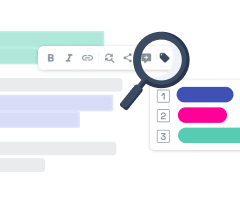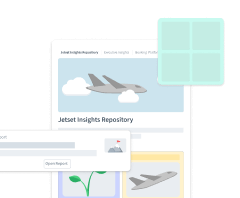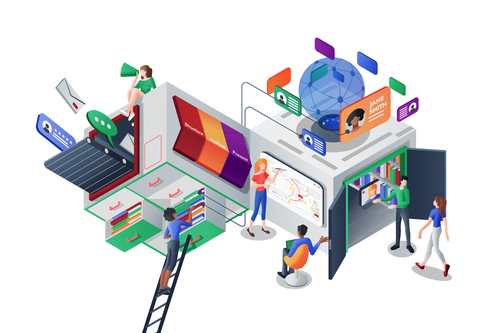

Successful Repository Implementation and Researcher Adoption
Congratulations on taking the significant step of introducing a research repository to your organization! It’s a big decision that comes with a number of benefits, both for your research team and the stakeholders involved. After the initial excitement, it's natural to feel a bit overwhelmed at the beginning. Building a new research repository from scratch may come with challenges, but the payoff - neatly structured and easily accessible data—is well worth the effort.
While setting up your Condens workspace is crucial (more on that later), a successful repository requires more than technical know-how. In this article, we'll guide you through the essential steps to ensure a smooth launch for your new research repository and long-term success. Let's dive in!
Step 1: Delegate a champion
After onboarding numerous teams to Condens, we've found that a key factor for success is having a designated champion to drive implementation and adoption from the start. This champion could be a Research Ops Manager, one of the workspace admins, or the UX Lead. By assigning one person with the responsibility of setting up the workspace, introducing the tool internally, and maintaining the repository, you minimize the risks associated with collective responsibility. The champion oversees data structuring, maintains taxonomy, and ensures that relevant research is regularly updated and shared across the organization. This approach not only streamlines the implementation process but also guarantees consistency and accountability throughout the implementation journey.
Step 2: Create the taxonomy & prepare your Condens workspace
To support you with a technical setup of your Condens workspace, we've developed a comprehensive guide that explores the process in detail. A crucial part of this setup is creating a taxonomy, which serves as the foundation for organizing and categorizing your data. Whether you're building a taxonomy from scratch or refining an existing one, it’s important to understand how data structures in Condens work.
In Condens, a taxonomy helps you systematically organize your data on different levels, which makes it easier to search, retrieve or analyze information. For example, you can filter your projects based on the date they were conducted or search for insights related to a specific product. This approach ensures that all users of the repository, from researchers to stakeholders, can efficiently find and utilize the information they need.
Once you are familiar with structuring your data in Condens, it’s time to start building and implementing the taxonomy in your workspace. If you need any assistance in defining the terms you should use, we have prepared a set of practical exercises and guides to help you develop the right taxonomy for your repository:
You can work on these exercises individually or organize an internal workshop to brainstorm with your colleagues on potential terms and structures. Additionally, the resources include useful tips on what makes a good taxonomy and a guide to Condens Taxonomy Dimensions.

As part of our Business and Enterprise plan, you have the chance to schedule a Taxonomy Workshop with our Customer Success Managers. They will collaborate with you, offering guidance and suggestions to establish the initial structure of your taxonomy.
Step 3: Plan the onboarding process for your team
Now that your Condens workspace has been fully prepared, it’s time to invite your team (that is all the colleagues who are involved in research activities) to join you. Making sure that everyone is familiar with the tool and ready to start using it is essential! Depending on the size of your team and the number of users involved, you can consider different onboarding approaches. In our experience, one onboarding session is usually sufficient for smaller teams (3-10 users). However, if Condens is going to be used across multiple teams in your organization, it might be best to schedule separate sessions for each team.

If you need help with organizing an onboarding session for your colleagues, Condens offers a personalized onboarding call which includes a product walkthrough and a Q&A round to clarify your team’s questions.
Whether you’re organizing the onboarding on your own or scheduling an onboarding session with Condens, it's important to keep the invitation engaging! Providing a brief overview of the session's purpose and highlighting the benefits of attending can help generate interest among your team members. Below, you'll find an example of an invitation sent by a Research Ops Manager from a large organization that chose Condens as their repository:

Interested in using this email template for your team? Download it now to simplify your workflow!
Keep in mind that sometimes, a single onboarding session might not be enough to ensure a smooth repository usage. Consider scheduling a follow-up call with your team after a few weeks of utilizing the repository to discuss their initial experiences - it will allow you to identify and troubleshoot potential issues early in the process.
For larger organizations, it’s also a good idea to prepare a detailed guide on how to use Condens, such as PowerPoint slides. In this guide, you can include your full taxonomy structure, a list of Global Tags to be used across the repository, practical information on project management in Condens, an overview of templates and their application, as well as instructions for team members on submitting comments and feedback.

It’s important to always keep your organizational structure and size in mind when designing the onboarding process. If your repository is going to be used not only by researchers but users with other roles, you can take inspiration from one of our customers who established an extensive training program for designers and product managers to become “Research Deputies”. The program, which took a few weeks in total, included reading 2 books, going through a set of exercises and observing researchers on 2 projects. After that the newly appointed research deputies were ready to get a researcher seat in Condens, add reports and be ambassadors of research in their teams.
What's next?
By implementing the practices outlined in this article, you and your team are laying a solid foundation for a successful journey towards building a long-term and well-structured research repository. As you and your colleagues begin creating your first projects in Condens and developing your research outcomes, it’s natural to start sharing them across a wider audience and involving other members of your organization.
To help with that, we’ve put together a comprehensive guide on driving stakeholder adoption and engagement, covering best practices for introducing stakeholders to the repository and making research insights more accessible across your company.
Building a successful research repository is an ongoing process, and each step brings new opportunities to strengthen research visibility and impact. With the right approach, your repository can become an essential resource that drives informed decision-making across your organization.







